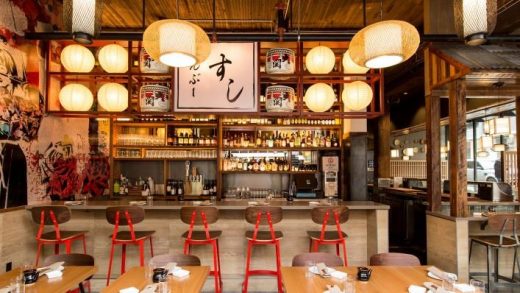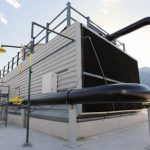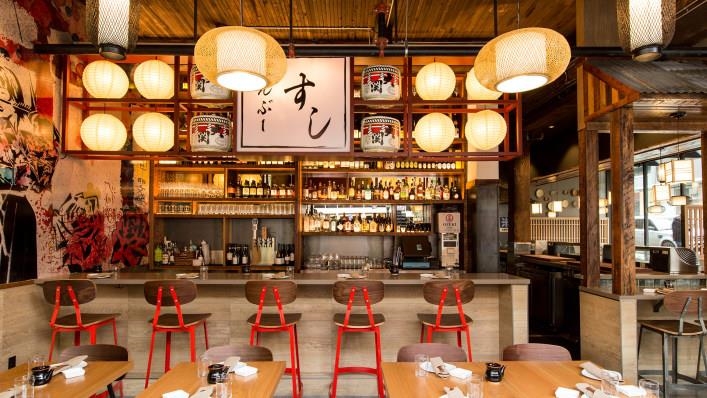To Create A Carbon-Neutral Restaurant, First You Have To Measure The Footprint
One of the main promises of the farm-to-table movement is that it reduces food miles: Restrict the distance your ingredients travel on their path to plate, and you’ll spend less fuel on transportation and refrigeration, curbing carbon emissions which contribute to greenhouse gasses.
The problem is that’s tough to measure. Plus, it’s woefully incomplete: Pretty much anything caught, grown, or raised requires ingredients to become ingredients, which means factoring in emission from the creation and use of more behind-the-scenes inputs, everything from manufactured fertilizer for crops, to animal feed and fueled-up tractors. While lots of online calculators are available for restaurants to try to track their footprint and impact, most only cover surface level math for daily operations, things like kilowatt-hours of electricity to power a restaurant, or gas used per food-mile.
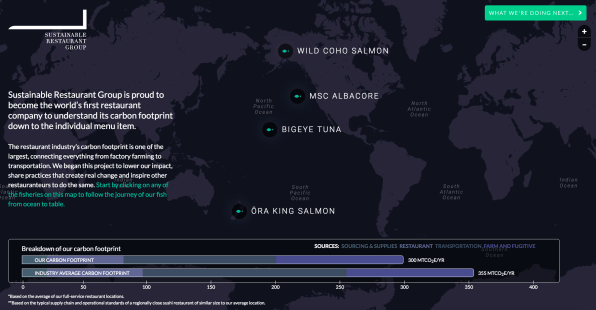
To solve those issues, Blue Star Integrative Studio, a green business and building evaluation firm, has created its own calculations to deeply track restaurant operation and supply chain emissions, and then compare the result to typical competitors within the same field. The company, which has done similar work for food product companies like Clif Bar, was commissioned to do that by Sustainable Restaurant Group in Portland Oregon, which has made their results available online in a novel way. Potential diners can not only see the restaurant’s emissions footprint but how it might compare to other similar-themed eateries they might choose.
From a practical standpoint, the hope is that customers will begin to value whether the eatery has below-average emissions into their mental math when choosing where to eat. “I think any restaurant can take on the challenge of climate impacts of their supply chain, when they actually need to for business reasons,” says David Jaber, Blue Star Integrative’s director of optimization. “If you look at any array of drivers or market developments in larger restaurants with the larger supply chain footprints, the time to tackle the challenge is now, if not already.”
On average, Blue Star would charge anywhere from $5,000 to $25,000 for this kind of service, depending on a restaurant’s scale and activity. That doesn’t include re-assessment costs, which could accompany substantial changes.
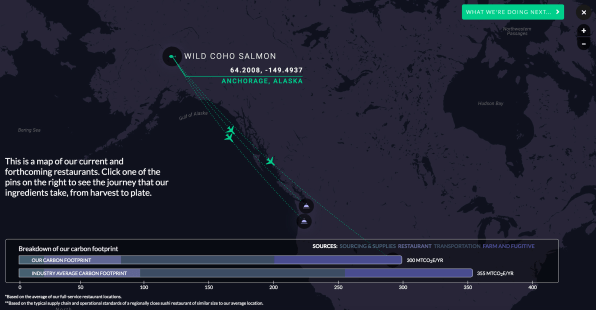
That’s a little different than how other players in this emerging industry operate. For instance, Zero Foodprint, a nonprofit started by Lucky Peach Editor-in-Chief Chris Ying, has developed a certification model that would audit operations in exchange for a fee per customer served, all prorated to drop as those place’s emissions do. As Eater has reported, Ming shared the process in a Lucky Peach article analyzing Noma in Copenhagen and Prime Meats in Brooklyn and works with Danny Bowien at Mission Chinese Food. According to the group’s website, it’s working with at several dozen well-known foodie restaurants already.
SRG doesn’t source as locally as some of those places. The group runs more than a half-dozen sushi restaurants in places like Portland and Denver, including Bamboo Sushi and QuickFish Poke Bar. In a way, it’s the prototype for what should be changed: It’s a chain and fast expanding. The group plans to add 10 more locations in the next two years, including in progressive markets like Seattle and San Francisco.
The point of all of these calculations is to first figure out where you stand, make changes to reduce emissions, and then invest in carbon offsets to become carbon neutral. Otherwise, customers might balk at the leftover environmental impact. To the end, Blue Star Integrative found, that a typical sushi restaurant generates a footprint of about 355 metric tons of carbon emissions per year. (By one analysis, that’s about the same flying round trip from New York to Europe nearly 120 times.) In contrast, each SRG location puts out more like 300 metric tons and is working to reduce that number. It also contributes to the Ocean Foundation’s SeaGrass Grow initiative, which plants underwater meadows near shorelines.
The footprint of every menu item isn’t listed on its site, although that may change eventually. For now, it’s just top sellers like sustainably-sourced Coho salmon, albacore, and tuna. “I think from a marketing, customer loyalty, and employee retention standpoint… it’s well worth the money that we spent to do this,” says SRG founder and CEO Kristofor Lofgren.
Other restaurants definitely get that this is a looming issue: For instance, McDonald’s has released its own internal audit, although the results aren’t totally meaningful because they were shared only in percentages. That beef accounts for 41% of emissions across the Golden Arches begs the question 41% of what? The actual tonnage might be gasp-worthy. Other massive operations like Darden Restaurants have joined massive accountability initiatives like the Carbon Disclosure Project—another would be the Climate Change Registry—but their individual efforts at reduction don’t say much about what’s the norm within their industries either.
What’s still lacking is a publicly accessible restaurant standard for what’s good or bad by food and concept type, complete with averages for who is improving things and how they are doing it. SRG is sharing a loose approximation of that, which Blue Star Integrative’s Jaber says follows the Greenhouse Gas Protocol, a formal and widely accepted accounting standard and backed up by scientific research from places like the Environmental Working Group, so it could be easily accepted into such a system were it to arise.
As more chains do this, others may follow. As Lofgren puts it: “We just want to get other people on board with the same ideals and thought processes we have to start shifting the industry in a more thoughtful direction.”
Portland, Oregon’s Sustainable Restaurant Group is working on new calculations to give a more full picture of the impact of the restaurant business.
One of the main promises of the farm-to-table movement is that it reduces food miles: Restrict the distance your ingredients travel on their path to plate, and you’ll spend less fuel on transportation and refrigeration, curbing carbon emissions which contribute to greenhouse gasses.
Fast Company , Read Full Story
(57)

